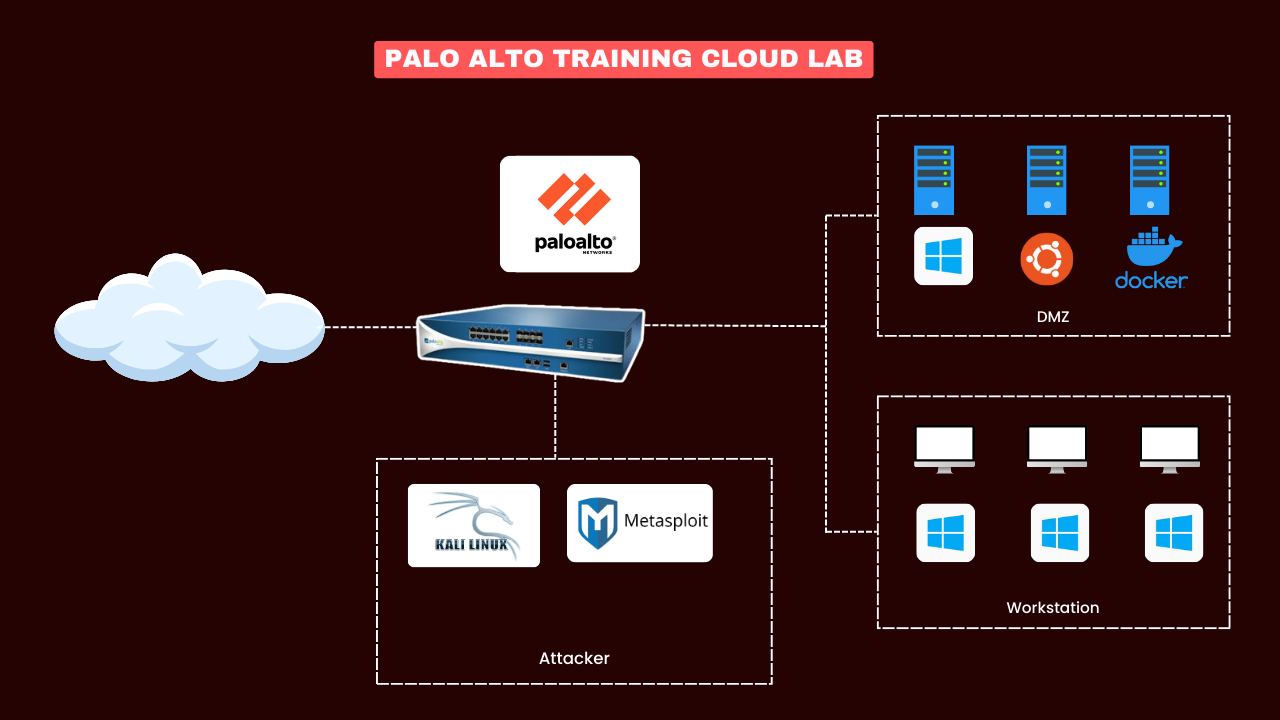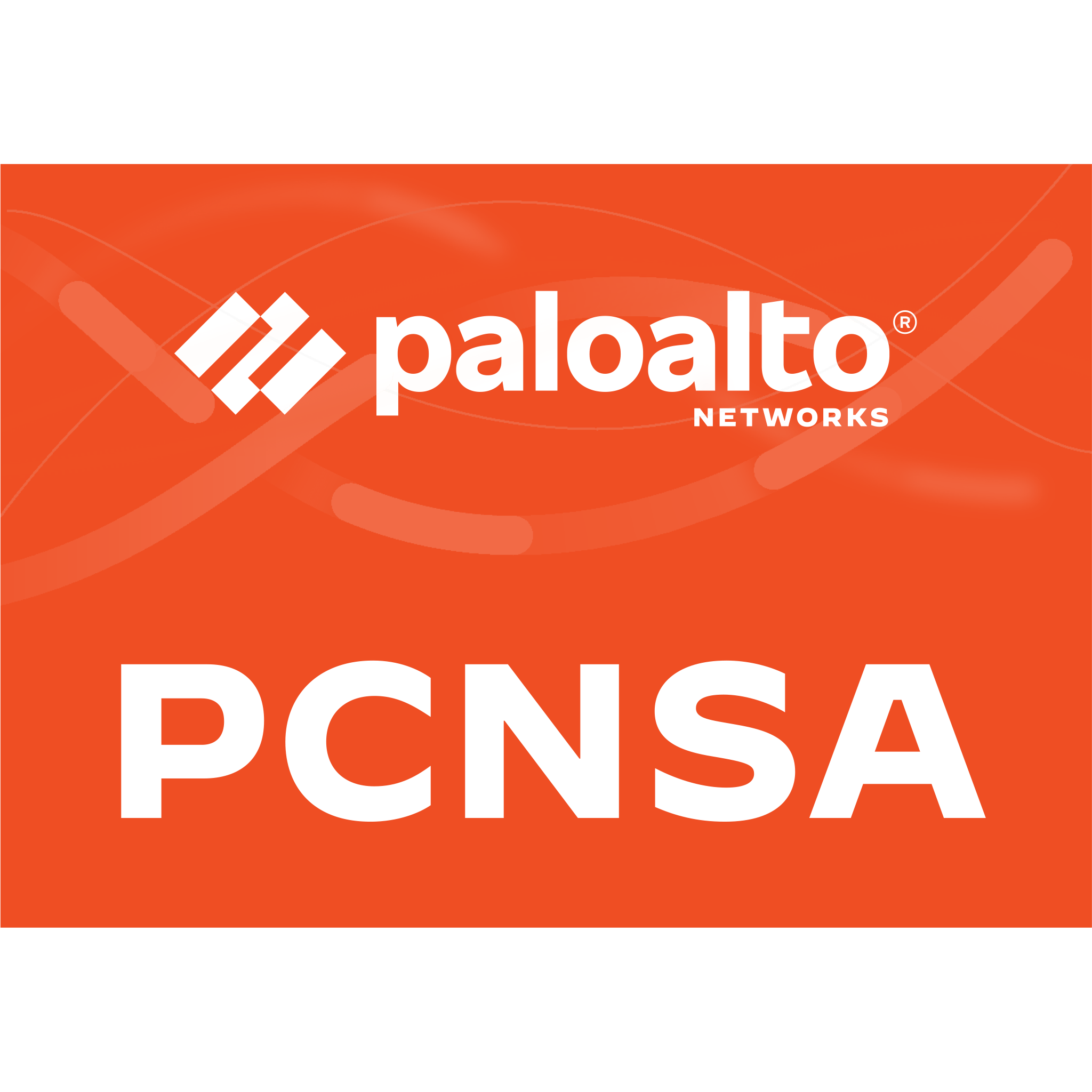Live Training
Palo Alto Firewall Live Training(PCNSA Exam)
- Duration: 40 Hours Live Training
- Cloud-based Lab Access
- 240+ Practice Questions for Mock Exam
- Life-time Community Access
About the Course
This Palo Alto Firewall Live Training is a complete guide to mastering Palo Alto Networks’ security platforms and preparing for the PCNSE Certification Exam. From installation to advanced features like App-ID, User-ID, and VPNs, this course empowers you with the knowledge and skills to deploy and manage Palo Alto firewalls effectively.

Target Audience
This course includes:
- 40+ hours of expert-led live training
- 15+ Real-World Scenarios
- 250+ Practice questions and mock exams for certification success
- Life-time Community Access
- Access the Class Recording
Curricular
Lessons:
- Identify Malware and Malicious Software
- Overview of Palo Alto Networks Firewall
- Install Palo Alto Firewall in VMware
- Install Palo Alto on EVE-NG
- Install Palo Alto in GNS3
- Install Palo Alto on ESXi
- CLI Access Modes and Basic Commands

Labs:
- Install and Configure Palo Alto Firewall on VMware
- Set Up Palo Alto in EVE-NG and Test Connectivity
- Basic CLI Command Practice
- Install and Configure Palo Alto in GNS3
- Verify Installation in ESXi
Lessons:
- Initial Configuration of Palo Alto Firewall
- Configure DNS and NTP in Palo Alto Firewall
- Activate Licenses and Subscriptions
- Dynamic and Software Updates Overview
- Management Interface Configuration
- Palo Alto Firewall Interfaces Overview
- Details on Zones in Palo Alto Firewall

Labs:
- Configure DNS and NTP Settings
- Activate Firewall Licenses and Perform Updates
- Configure and Test the Management Interface
- Create and Configure Firewall Zones
- Verify Connectivity Between Zones
Lessons:
- Routing Protocols: AD, Metric, and Routing Tables
- Virtual Routers in Palo Alto Firewall
- Static Routing: Configuration and Verification
- Default Routing: Configuration and Verification
- Dynamic Protocols: RIP and OSPF in Palo Alto
- Redistribute Routes in Palo Alto Firewall

Labs:
- Configure Static Routing
- Configure and Test Default Routes
- Set Up and Test RIP in Palo Alto
- Configure and Test OSPF in Palo Alto
- Route Redistribution Between Protocols
Lessons:
- Security Policy Concepts and Theory
- Granular Criteria and Controls for Security Policies
- Security Policy Action Settings Options
- Shadows Rule in Palo Alto Security Policies
- Test Policy Match Options
- Optimize Security Policies

Labs:
- Create and Test Security Policies
- Analyze Shadows Rules and Optimize Policies
- Configure and Verify Policy Match
- Implement Granular Security Policy Controls
- Perform Policy Optimization Using Policy Optimizer
Lessons:
- Introduction to Content-ID and Security Profiles
- Configure Antivirus Profile
- Configure Anti-Spyware Profile
- Configure Vulnerability Protection Profile
- Configure URL Filtering Profile
- Configure File Blocking Profile
- Configure WildFire Analysis Profile

Labs:
- Configure and Test Antivirus and Anti-Spyware Profiles
- Configure URL Filtering and Block URLs
- Set Up File Blocking Rules
- Test and Analyze Threats Using WildFire
- Monitor and Verify Security Profile Activity
Lessons:
- NAT Theory and Source NAT Types
- Dynamic IP and Port (DIPP) NAT
- Dynamic IP NAT (DIP)
- Static IP NAT Configuration
- Destination NAT: Port Forwarding and Translation
- U-Turn NAT Theory and Implementation

Labs:
- Configure and Test Dynamic IP NAT (DIPP)
- Implement Static IP NAT and Verify Traffic
- Configure Destination NAT with Port Forwarding
- Simulate and Verify U-Turn NAT
- Analyze NAT Traffic Logs
Lessons:
- Introduction to App-ID in Palo Alto Firewall
- Walkthrough and Details of Applications in Palo Alto
- Application Groups and Filters
- Custom Applications and Overrides
- Dependent and Implicitly Used Applications
- Application Updates and Security Policies

Labs:
- Configure Application Groups and Filters
- Create and Test Custom Applications
- Analyze Dependent Applications in Logs
- Configure Security Policies Based on Applications
- Monitor Application Traffic in App-ID
Lessons:
- Introduction to User Identification (User-ID)
- Captive Portal for User Authentication
- Active Directory, DNS, and Groups Configuration
- Palo Alto Firewall Active Directory Integration
- Role-Based Access Control and Administrator Accounts

Labs:
- Configure Captive Portal for Authentication
- Integrate Active Directory with Palo Alto Firewall
- Set Up User-ID Policies Based on Groups
- Test Role-Based Access Control for Admins
- Analyze User Traffic and Authentication Logs
Lessons:
- Redundancy and High Availability (HA) Theory
- Configure Active-Passive High Availability
- Configure Active-Active High Availability
- Monitor HA Status and Failover Events
- Troubleshooting High Availability Scenarios

Labs:
- Set Up Active-Passive High Availability
- Simulate Failover Scenarios and Monitor Recovery
- Configure Active-Active High Availability
- Test HA Synchronization and Redundancy
- Analyze Logs for HA Failures
Lessons:
- Cryptography, Encryption, and Hashing Concepts
- VPN Types and Protocols: IPSec, IKE, and SSL
- Site-to-Site IPSec VPN Configuration
- Remote Access VPN with GlobalProtect
- Monitoring and Troubleshooting VPN Connections

Labs:
- Configure a Site-to-Site IPSec VPN
- Set Up and Test Remote Access VPN
- Verify VPN Traffic and Connections in Logs
- Simulate VPN Failures and Recovery Scenarios
- Monitor VPN Sessions Using Palo Alto Tools
Lessons:
- Log Types in Palo Alto Firewall
- Configure and Verify Syslog, NetFlow, and SNMP
- Perform Packet Capture Using GUI and CLI
- App Scope and ACC Overview
- Backup and Restore Configuration in Palo Alto

Labs:
- Configure Syslog and Verify External Logging
- Set Up NetFlow and SNMP for Network Monitoring
- Perform Packet Capture and Analyze Results
- Test ACC for Traffic Analysis
- Backup and Restore Firewall Configurations
Instructor

Senior Security Consultant
- With over a decade of experience in cybersecurity and author of multiple works on security monitoring, Rajneesh is a trusted expert in open-source security tools, cloud security, and SOC automation. He has implemented and optimized ELK deployments for global clients and specializes in turning raw log data into actionable security intelligence. Rajneesh’s instruction style is both practical and thorough, ensuring you gain job-ready ELK skills.
REQUIREMENTS
- Basic knowledge of networking concepts
- Familiarity with IP addressing and routing
- A willingness to learn and explore advanced configurations


PCNSA Certification
- Exam Name: Palo Alto Networks Certified Network Security Admin(PCNSA)
- Duration: 90 minutes
- Passing Score: ~70% (varies)
- Questions: 50-60 multiple-choice questions
- Exam Fee: $175 USD
- Delivery: Online proctored or at a Pearson VUE test center

Testimonial
What alumni say about us






FAQs
Lorem ipsum dolor sit amet, consectetur adipiscing elit. Ut elit tellus, luctus nec ullamcorper mattis, pulvinar dapibus leo.
The course spans 40 hours of live, instructor-led training with additional self-paced lab practice.
Yes, if you have basic networking knowledge, this course will guide you step-by-step.
No, we provide access to virtual lab environments like VMware, GNS3, and EVE-NG.
Don’t worry! All sessions are recorded and accessible to you for lifetime learning.
Yes, our team will guide you through the registration process for the exam.
You will receive recorded sessions, lab access, detailed course materials, and mock exams.
While this course prepares you for the PCNSE certification, you will also receive a training completion certificate from us.
You will get post-training support for queries, lab access extensions, and career advice.
Yes, we offer a money-back guarantee within the first week if you’re unsatisfied.
Yes, we offer guidance and support after the training for any queries or career advice.





